My final samples are developed from the gathered fabric samples I did in task 4.
The aim for my final sample was to make it as versatile as possible to wear, so that it could be placed anywhere on the body. To do this, I needed to create a structure that would move but also stay in place when shaped. the wire in my previous samples worked well, so I decided to see how far I could take this and whether it would be possible to sculpt the fabric enough that it would fit closely to the body. My design has several layers, meaning that the wires wont be in contact with the skin and cause irritation. I started by sewing thin wires in a running stitch across the fabric in one direction. One end of the wire is fixed into the fabric and secured and the other sticks out of the side of the bandage, with a little loop made at the end. This means that the wearer can pull the wire which in turn gathers the fabric in certain areas, meaning that it can be shaped to fit any part of the body. There are also two wires running perpendicular to the others at the edges of the fabric, which can also be gathered.
I then added a padded layer of wool to the underside of the bandage, which would be soaked in an antibacterial property extracted from mushrooms and mycelium. this would be mixed with honey which has been used to treat burns for thousands of years, originating in ancient Egypt. It was essential to me that my bandage is made using natural fibres and plants, there is a wealth of knowledge about natural healing which has been lost and is no longer used in modern medicine, which is a shame.
I used a faux shammy leather for my sample, but ideally it would be real shammy leather because of its highly porous nature.
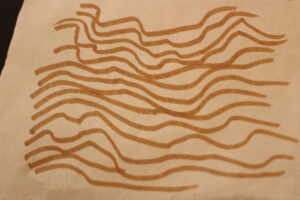
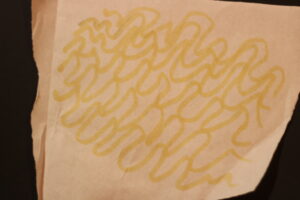
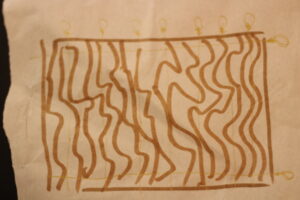
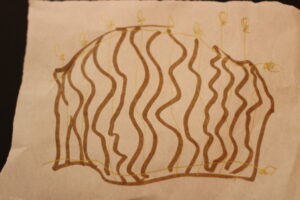
First sample.
shown flat and stretched out to its fullest, I wanted the wires to be visible so that they compliment the brown colour of the fabric with a pop of shinyness.
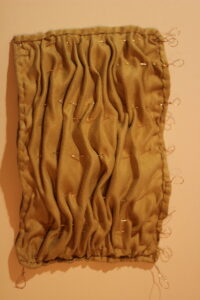
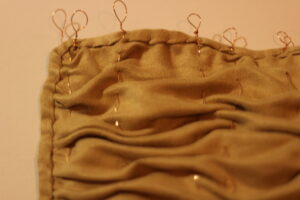

here I have pulled some of the wires to show how versatile in shape it can become. I was also thinking about how mushrooms grow, starting out very small and then swelling, with their gills expanding.
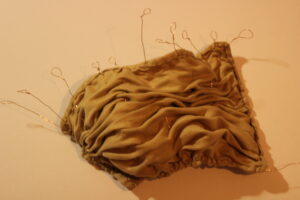
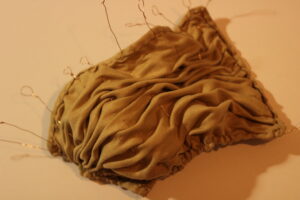
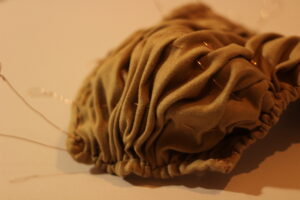
The back side which would be against the skin is padded with wool, which could be swapped out when the bandage needs changing. It could also be swapped for other materials, depending on what each person’s skin is irritated to.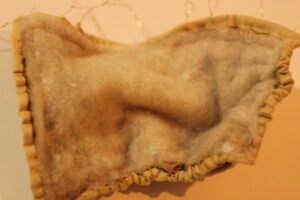
I have taken a series of images with it placed on different areas of my body, and it worked everywhere! however it would need to have some ties to attach it to some areas. I think it especially works on the chest/neck area because it conforms to the curvature of your clavicle.
also sorry for the bad quality of images, I was having technical issues with my camera.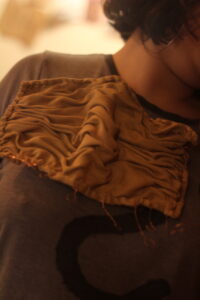

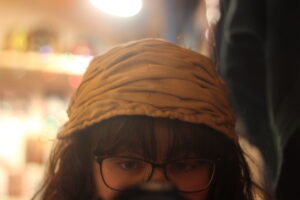
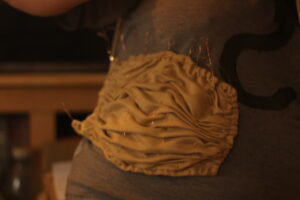
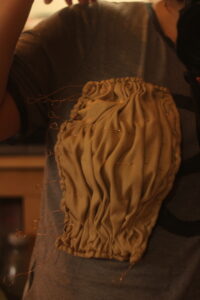
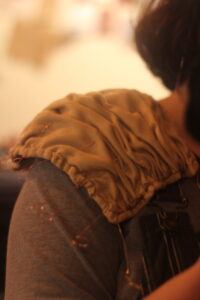
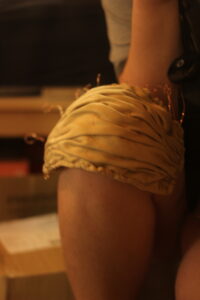
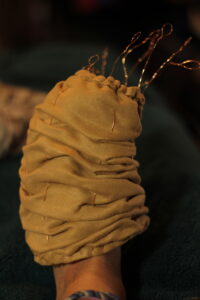
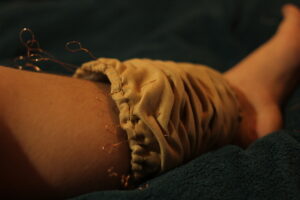

second sample.
for my second fabric sample, I wanted to experiment with a different fabric to change the texture, but still use the same technique to create the abstract smocking. I made the bottom layer out of the same faux shammy leather, but for the smocking I used a dark yellow velvet. This gives the piece a much more elegant and expensive feel, becoming very tactile and pleasurable to touch (unless you have a velvet phobia).
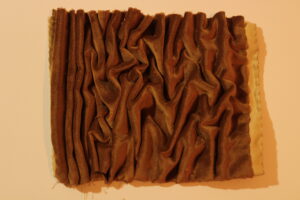
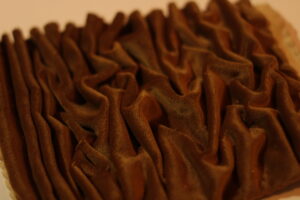
I also found this moss called sphagnum moss, which was used during WW1 for bandages. this wonderful photo below is from the village where I grew up and shows a group of children and women with large sacks of the moss which would then be sent off to be used for bandages, because it is very porous and soaks up fluids.
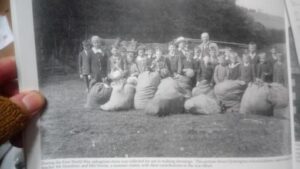
I experimented with placing it on the underside, so that its purpose would be to soak up any fluids oozing from the wound, but also on-top as a decorative element. I really like the juxtaposition of the green against the deep browny yellow of the velvet.
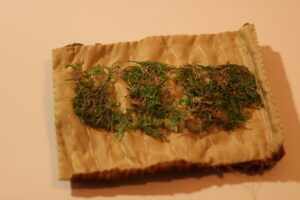
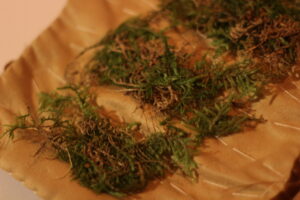
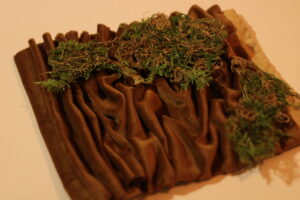
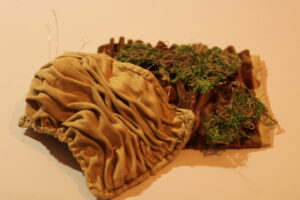
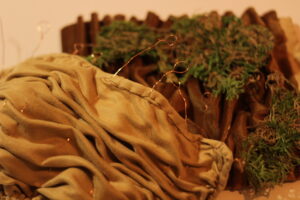
To conclude, my design uses natural materials and properties to create a versatile bandage for burn victims. the colour palette is kept simple so as not to stand out too much against the skin but also not to be the same colour as the skin, as all skin colours are different.
I have enjoyed this project, especially the making part. I would be interested to explore further with these techniques and apply them to clothing, to make pieces that change shape and is adjustable, perhaps for children because they are constantly growing.
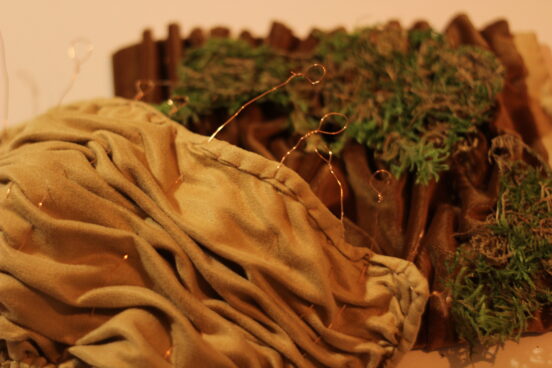


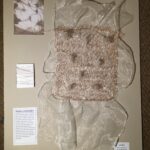
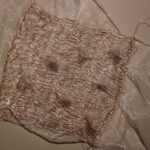

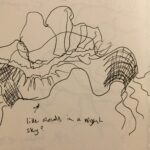
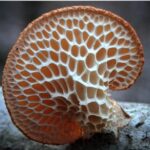

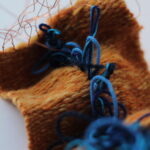

nadamson
5th November 2020 — 12:02 pm
Yarrow I think the idea is there for final outcomes but I dont think the refinement is. I think if you look back to your first sample boards there were so many exciting and more beautiful sample ideas of mixing fabric and trapping into the plastic. I would definitely try and do another sample that refers back to that first board you did and some of the techniques and then refine it and really look at your shapes and patterns, you have time x